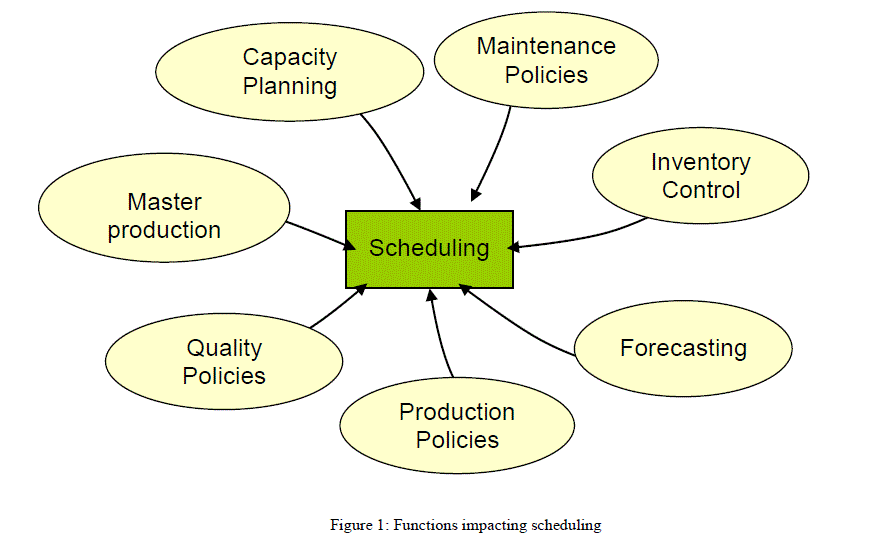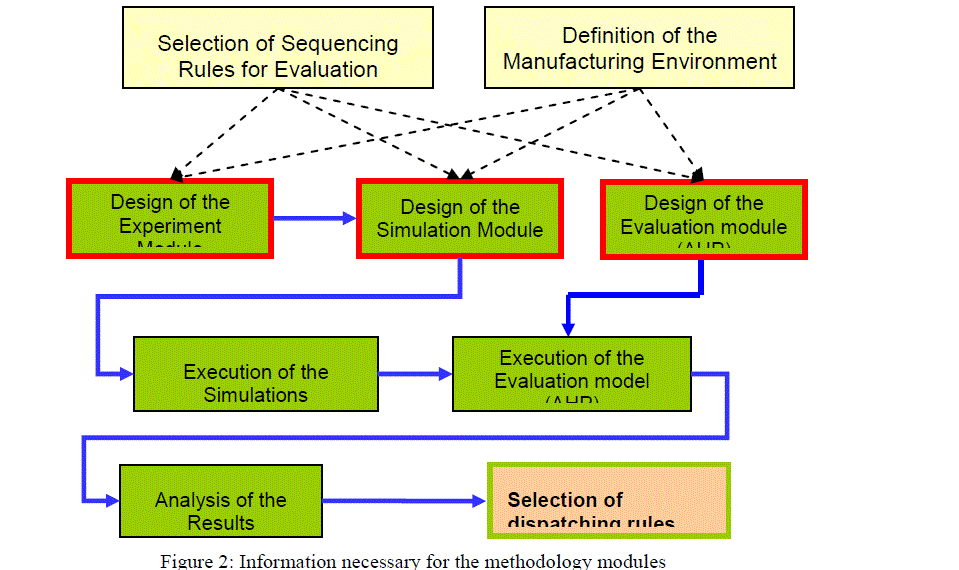ISSN ONLINE(2319-8753)PRINT(2347-6710)
ISSN ONLINE(2319-8753)PRINT(2347-6710)
| Ratheesh. K, Udayakumar. P, Udhayakumar. C Department of Mechanical Engineering, Magna College of Engineering, Magaral, Chennai, India |
| Related article at Pubmed, Scholar Google |
Visit for more related articles at International Journal of Innovative Research in Science, Engineering and Technology
The role of scheduling in manufacturing systems has become very important, especially in today’s competitive industrial environment, which calls for time and cost effective production systems. Production scheduling is one of the most difficult tasks to be carried out within this environment: of its customers which would lead to increased competitiveness and profitability. Finally, given the fact that manufacturing activities are often characterized by significant stochastic and dynamic attributes, it is not surprising that the scheduling domain remains one of the hottest issues. On the other hand, technology progresses with the same pace as industrial systems do, and various methodologies and techniques have been adopted to solve scheduling problems. The problems related with scheduling lead to frequent revision of schedules that have already being dispatched on the production floor. First, the performance that a schedule exhibits usually is being measured based on a single criterion. However, manufacturing performance is multi-dimensional, and targets may even conflict with each other. Therefore, schedules have to be revised in order to comply with criteria which initially were not taken into consideration. Second, schedules are rarely evaluated before they are dispatched on the production floor, despite the fact that there is existing technology which allows that. This paper suggests a new methodology in evaluating the scheduling schemes. Instead of the old methodology, a new hybrid technique is proposed.
Keywords |
| Scheduling, PERT |
INTRODUCTION |
| It is important, to understand the role of scheduling as part of a production system. Furthermore, we need to identify the underlying reasons for the remaining issues with scheduling. Understanding the obstacles which characterize scheduling is the key for designing schedules that will boost the performance of the manufacturing floor. Scheduling involves the allocation of resources to accomplish specific tasks over a period. Scheduling performance is measured by the various metrics which reflect the floor shop efficiency. Throughout successful scheduling, throughput should be optimized; cycle times should be reduced; the demand should be met in a timely fashion; the resources should be utilized according to the production policies supported. On the other hand unexpected disruptions are happening during the production; the resources are limited; often several duties have to be allocated to the same resource; expediting orders have to be accommodated while a current schedule is implemented; delivery of raw material is not always on time. These are some of the situations that scheduler often has to cope with. It becomes apparent that scheduling is difficult to be carried out, in the same degree that it is difficult to manage entire production systems successfully. The obstacles which contribute to the degradation of the performance of scheduling systems can be distinguished into two different categories: |
| ïÃâ÷ the inherent nature of scheduling and the manufacturing environment ïÃâ÷ the scheduling techniques adopted |
| Starting with the first category, an observation is that in the majority of manufacturing environments, scheduling has to cope with uncertain and dynamic conditions. This is an inherent weakness especially in predictive scheduling systems |
| In this case, the activities have to be predetermined based on static information about dynamic conditions which can change while the schedule has already being dispatched. Even in the case of pure real-time schedules, where the activities are based on dynamic information, the scheduling decisions remain discrete over a period. It is not certain that the implemented schedule will not need further adjustment until the next scheduling point. In both the cases, revised schedules have to be dispatched on the production floor. This fact can cause nervousness to the production system, instability in a balanced line, and excess WIP. The problem with uncertainty remains unresolved, although most of the systems available try to cope with it, achieving some degree of success. Another inherent problem associated with scheduling activities evolves from the impact of other functions in the manufacturing system. These functions, presented in figure 1, have direct or indirect impact to the performance of schedules |
 |
| Among these functions, the production planning activities like, Forecasting, Capacity Planning, Master Production Planning, and Production Control policies have the strongest impact. Since scheduling is driven from Production Planning, there is a high correlation between Production Plaanning and Scheduling. The rest of the other functions that impact manufacturing are: Inventory control policies, maintenance policies, and quality policies. These functions attribute mostly to the stochastic and dynamic nature of scheduling, because they introduce: |
| i. uncertainty about material availability |
| ii. production capacity variability |
| iii. uncertainty regarding the available time slots for production |
| iv. variable products cycle times |
| Other obstacles of scheduling systems arise from weaknesses that are inherent to the methodologies adapted. Some of these deficiencies are common among these methods and these are reviewed as follows: |
| ïÃâ÷ Most methods concentrate on solving theoretical problems. Therefore, for simplifying reasons, these methods omit some or all of the scheduling complications that were previously indicated. The usual result is that when it comes to transfer such methods to real world problems, the methods do not exhibit the same performance as in the theory. The gap between theory and practice has been addressed by researchers leading to a degree of improvement. |
| ïÃâ÷ In the past, scheduling problems to a great extent were attempted, to be solved by using solely analytical methods like OR models and mathematical methods. However majority of real-world scheduling problems fall into the so called NP-Hard category. The practical implication of this fact is that it is extremely difficult, if not impossible, to obtain optimal solutions for large-scale scheduling problems, from analytical methods. However, it is still possible to obtain feasible and good solutions, by using combination of analytical and other techniques adopted for solving scheduling problems like Simulation, Artificial Intelligence and Heuristic methods. |
| All the above observations provided the stimuli for this paper, in order to contribute positively in the direction of improving the scheduling systems, recognizing the barriers in respect with the manufacturing, and identifying weaknesses of current approaches to the problem |
Approach |
| This paper proposes an alternative scheme which would allow the scheduler to select a schedule tactics from different alternatives. The scheduler would be able to evaluate the behavior of scheduling under different conditions and to choose, with a certain degree of confidence, what fits best to the particular environment. This is implemented by proposing the following outlined methodology for selecting a schedule: |
| i. Designing an experiment using |
| a. The manufacturing environment variables which impact scheduling performance as the factors of the experiment |
| b. Performance metrics as the response variables |
| ii. Creating a robust representation of the manufacturing system adopting simulation modeling. |
| iii. Integrating within simulation model, logic that describes precisely any of the scheduling schemas under assessment. |
| iv. Creating a flexible modeling environment for convenient experimentation |
| v. Executing simulation runs according to the combinations indicated by the D.O.E |
| vi. Creating a Hierarchical Multi-Criteria model for selecting a schedule among the scheduling schemes for each set of the experiments where |
| a. The objective is to assess, and finally select scheduling scheme |
| b. The criteria are the performance metrics |
| c. The alternatives are scheduling schemes |
| vii. Validating the model with an extensive example based on data originating from a real manufacturing environment |
Conceptual Design |
| The proposed methodology utilizes three widely accepted in engineering techniques; the Design of Experiments, Simulation modelling, and Analytical Hierarchy Process. The methodology should be applicable in a real manufacturing environment. |
Experiment Set-Up and Proposed Methodology |
| Experimentation is one of the fundamental scientific method. Design of Experiments (D.O.E.) is a structured approach to conduct experiments by measuring the characteristics of an object of interest, which are called response variables, while systematically modifying the values of other independent characteristics, which are called factors. The purpose is to assess the significance of the impact of changes. Design of Experiment has been widely utilized for industrial purposes focusing mainly in obtaining information regarding the factors affecting a manufacturing process from a few observations. |
Simulation Modeling |
| Computer Simulation is one of the most powerful tools for designing and analyzing systems, as well as an excellent means for carrying out experiments in a computer-controlled environment. Through simulation modeling, systems can rapidly be developed avoiding the need to build up expensive real systems without testing them. Therefore, it is not surprising that simulation finds various applications in manufacturing. Especially, discrete-event simulation has traditionally been utilized to support various manufacturing activities as longterm planning, and designing manufacturing systems. Furthermore, as already mentioned, simulation modeling has been adopted as a means of scheduling. In this study, simulation serves as the means for carrying out the experiment defined by the D.O.E. set-up. The desired output which is obtained will be then used as the input for the Analytical Hierarchy Process model. |
 |
Analytical Hierarchy Process |
| The Analytic hierarchy process is a powerful and flexible multi-criteria decision-making process, which allows complex decision problems to be resolved . The A.H.P. is a top-down hierarchical approach, which attempts to break down a decision into smaller portions. The criteria, under which the candidate solutions are examined, are prioritized based on their importance. Then, the alternative solutions are compared and a best solution is selected. Furthermore, there are provided mechanisms, which control the logic of preferences and weights, in order to achieve high level of consistency in the decision process. In this methodology, A.H.P. serves as the means to carry out the multi-criteria based decision regarding the selection among the scheduling rules the one - or ones - which exhibit the desired performance. |
II. CONCLUSION |
| The potential for adopting such a methodology lies in the benefits from the combination of the tools that have been adopted towards scheduling issues, as these were addressed in earlier sections. The utilization of simulation as the experimental means allows: ïÃâ¬Ã to depict a series of different situations which can occur in manufacturing environment where uncertainty factors do and to examine the impact of different scheduling techniques before dispatching them in the manufacturing floor The utilization of a multi-criteria technique allows: ïÃâ¬Ã to evaluate several scheduling techniques using multiple performance metrics which is one of the main calls for improvement according to the literature review As the matter of fact the combination of these two aspects of the proposed methodology offers a valuable tool for assessing in a structured approach scheduling under conditions of uncertainty, using multiple criteria, before dispatching to the manufacturing floor. The success of the methodology depends on activities that occur in two different phases: |
| The implementation phase and the ability to model precisely all the aspects of the manufacturing environment ïÃâ¬Ã The application phase and the ability to assign appropriate and meaningful weights of importance to each of the evaluation criteria If any of these two activities fail to serve their purpose as described above, there is a considerable possibility that the model will lead to erroneous decisions regarding the performance of the scheduling rules, and consequently the selection of the best rule, with major consequences in the manufacturing system. Therefore a rigorous approach must be adopted in the development phase of the modules in order to assure that the prerequisites are met. Depending in the complexity of the environment, the development phase of the methodology may be expensive and time consuming. |
References |
|